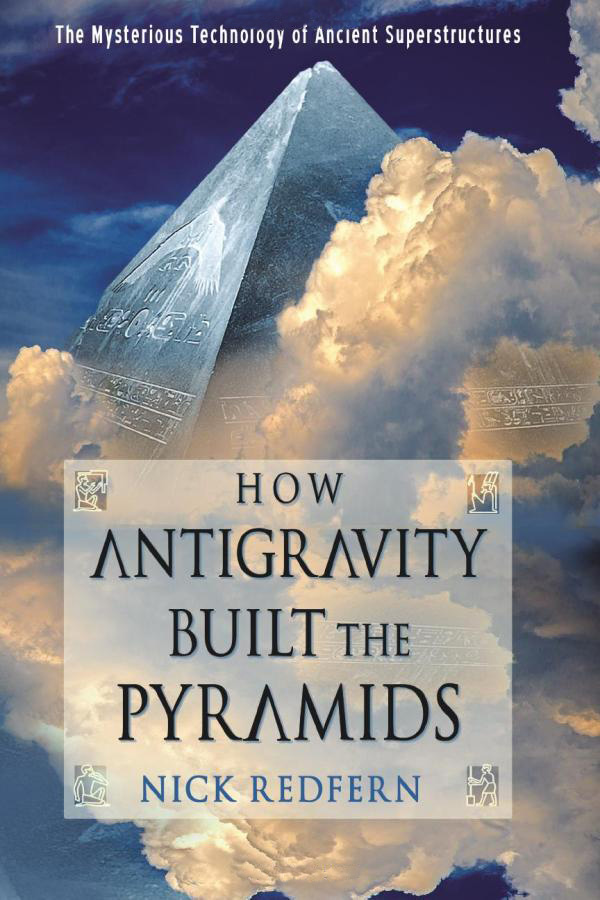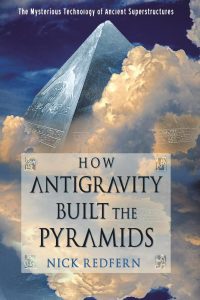Author Nick Redfern’s book, How Antigravity Built the Pyramids, explores the Lost Secrets of the Ancients and the Time When Stones Floated High over Egypt.
Throughout history, folklore, and mystery, tales have circulated of massive stones being moved through the air effortlessly by sound. Bizarre? Well, yes, it is. That doesn’t take away the fact that sound was, and still remains, the key to the construction of the pyramids of Egypt, Stonehenge, the stone figures of Easter Island, and the massive stones at Baalbek, Lebanon. Were they the work of ancient humans or of equally ancient extraterrestrials?
How Antigravity Built the Pyramids delves into specific stories and theories:
- A 9th-century story of a mysterious papyrus with the power to move large stones at the Giza Necropolis
- The Mayan story of the construction of the Pyramid of the Magician said to be overseen by a small humanoid who could whistle large stones into place.
- Native American stories of ancient priests being able to make stones light to move easily
Nick argues it was not literally music and whistling that somehow raised large stones, but both have one thing in common: sound. Acoustics. Almost certainly, acoustic levitation was at the heart of these incredible feats.
The truth of the science behind acoustic levitation was lost and forgotten for ages, with little more left than fanciful tales of music, whistles, a curious papyrus, and strange metal rods that could achieve incredible feats in the air. Today, we are finally starting to get a grasp on this incredible technology, a technology that may have been the work of ancient humans, aliens from faraway worlds—or, perhaps, a combination of the two.
In his excerpt below, Nick highlights some of the levitation technologies that exist today.
We’ve addressed the issue of levitation in ancient times, during the Middle Ages, in Victorian times, and even when the Cold War was still afoot. There’s just one time frame for us to focus on now: the present day. How do scientists see levitation today, particularly acoustic levitation? That’s a good question, considering that although acoustic levitation is a real phenomenon, it has become connected to the “ancient astronauts” controversy. Without revealing their names, I know of two scientists who flatly refuse to bring the “Egypt and antigravity” angle of all this to the table, for fear of having their reputations smeared. Or, even worse, completely destroyed. In some respects, we can’t blame them for having concerns. Big concerns. Despite my words, the majority of scientists in this arena look at the “ancient astronauts” / acoustic levitation subject with an interesting mind but largely ignore the kinds of work that people like me are doing.
So it goes.
Regardless of what the scientific community thinks of ancient mysteries and stones in the skies, the fact is that, right now, a great deal of work is being done on this particularly controversial phenomenon, even though, in many ways, it baffles us today, but apparently didn’t do so, to any degree, in centuries past. Brett Tingley is someone who has taken keen note of acoustic levitation and realizes the important and planet-changing potential it could have for us as a civilization. He says of all this:
Acoustic levitation – using sound waves to levitate objects— has been the subject of past experiments and has shown promise in achieving true levitation. However, scientists have previously been limited to levitating very small objects or have only levitated objects along one axis, meaning objects had to be semi-restrained.1
And, largely, that’s the problem. Right now, even I have to concede that we are still caught in a situation that certainly allows for acoustic levitation to exist but that completely lacks the much-needed muscle to utilize it in the fashion that the Egyptians, the people of Easter Island, and the creators of Stonehenge did all those years ago.
Progression in the 21st Century
Some of the most important data in this arena can be found in an important document from June 2016. It was prepared by Marco A.B. Andrade, Anne L. Bernassau, and Julio C. Adamowski. Its title: “Acoustic Levitation of a Large Solid Sphere.” The words of the groundbreaking trio state the following: “We demonstrate that acoustic levitation can levitate spherical objects much larger than the acoustic wavelength in air.”2
A Whole Host of Other Wacky Applications
The team at Mysterious Universe—for whom I work on a regular basis— asks a question that anyone who has an interest in this field wants answered: “Is levitation real?” The decisive response (hypothetical, to a degree):
Sure it is. Scientists have been levitating objects in laboratory conditions for decades. Magnetic and electrostatic levitation have long been used to create conditions for containerless storage and analysis, for materials that react with other common elements. NASA uses them regularly. But there’s another method you might not be aware of. Acoustic levitation is quickly becoming a superstar of fringe science. It is used in lab settings for the same reasons as above, and in the research of sound waves and their effect on the environment. But some say it’s been used outside the lab for centuries, and maybe even millennia.
Indeed, as we’ve seen.
There is yet a further advance in the field of levitation; this one came along in 2019. Writer Sequoyah Kennedy said:
[N]ew research from the California Institute of Technology has apparently found a way to levitate macro-scale objects using nothing but light. Scientists at Caltech say that, once implemented, this technology would allow a spacecraft to surf its way on a beam of light to the nearest planet outside our solar system in as little as 20 years.3
Undeniably impressive.
A Method that Could Levitate Macroscopic Objects
In an article titled “Self-Stabilizing Photonic Levitation and Propulsion of Nanostructured Macroscopic Objects,” penned by Ognjen Ilic and Harry A. Atwater, we learn something very important. Notably, Ilic says: “One can levitate a ping pong ball using a steady stream of air from a hair dryer. But it wouldn’t work if the ping pong ball were too big, or if it were too far away from the hair dryer, and so on.”4
What this demonstrates, though, is that great leaps and bounds are being made in this field. Harry Atwater, a Howard Hughes Professor of Applied Physics and Materials Science at Caltech, says something incredibly important, too. It also gives us food for thought in relation to where, precisely, all of this will be heading in the near future:
We have come up with a method that could levitate macroscopic objects. There is an audaciously interesting application to use this technique as a means for propulsion of a new generation of spacecraft. We’re a long way from actually doing that, but we are in the process of testing out the principles.5
A Virtual Vortex
Paul Seaburn, of Mysterious Universe, said in 2018:
In a new study published this week in Physical Review Letters, lead author Dr. Asier Marzo of the university’s department of mechanical engineering reveals how researchers have broken the size barrier that restricted previous levitation devices and tractor beams from raising anything more than tiny particles. Even more impressive, they’ve managed to control the deafening sound as well.6
An Important Step Forward
The particular paper that Seaburn was talking about goes by the title of “Acoustic Virtual Vortices with Tunable Orbital Angular Momentum for Trapping of Mie Particles.” In summary, there are these words from the team of Asier Marzo, Mihai Caleap, and Bruce W. Drinkwater:
Acoustic vortices can transfer angular momentum and trap particles. Here, we show that particles trapped in airborne acoustic vortices orbit at high speeds, leading to dynamic instability and ejection. We demonstrate stable trapping inside acoustic vortices by generating sequences of short-pulsed vortices of equal helicity but opposite chirality. This produces a “virtual vortex” with an orbital angular momentum that can be tuned independently of the trapping force. We use this method to adjust the rotational speed of particles inside a vortex beam and, for the first time, create three-dimensional acoustics traps for particles of wavelength order.7
Ancient Origins, who are far more than familiar with the mysteries of the distant past, have been keeping a careful look at how all of this is playing out in the 21st century:
In two experiments, scientists have successfully levitated lightweight polystyrene balls greater in size than the wavelengths used to elevate them, which represents an important step forward in the management of the force of concentrated sound. One of these experiments, carried out by a joint team of researchers in the UK and Brazil in 2016, lifted a 50-millimeter polystyrene ball several centimeters off the ground, where it remained suspended for as long as the sound waves were generated.8
The U.S. Government and its Interest in Levitation
Now it’s time to see what the government of the United States thinks of all this. After all, we know that Morris Jessup was approached by the U.S. Navy in the 1950s and Bruce Cathie had correspondence with the Defense Intelligence Agency. It makes sense that research in this area should still be going on right now. Indeed, it is. To learn what the government knows of acoustic levitation, we have to go knocking on the door of the Department of Energy Office of Scientific and Technical Information. They have found something that’s undeniably important:
We demonstrate that acoustic levitation can levitate spherical objects much larger than the acoustic wavelength in air. The acoustic levitation of an expanded polystyrene sphere of 50 mm in diameter, corresponding to 3.6 times the wavelength, is achieved by using three 25 kHz ultrasonic transducers arranged in a tripod fashion. In this configuration, a standing wave is created between the transducers and the sphere.9
Also from the government:
The axial acoustic radiation force generated by each transducer on the sphere was modeled numerically as a function of the distance between the sphere and the transducer. The theoretical acoustic radiation force was verified experimentally in a setup consisting of an electronic scale and an ultrasonic transducer mounted on a motorized linear stage. The comparison between the numerical and experimental acoustic radiation forces presents a good agreement.10
We still aren’t finished with officialdom.
Government Work Continues
The U.S. government’s United States National Library of Medicine, a branch of the National Institutes of Health, offers this: “Levitation and manipulation of objects by sound waves have a wide range of applications in chemistry, biology, material sciences, and engineering. However, the current acoustic levitation techniques are mainly restricted to particles that are much smaller than the acoustic wavelength.”11
Government scientists explain:
In this work, it is shown that acoustic standing waves can be employed to stably levitate an object much larger than the acoustic wavelength in air. The levitation of a large slightly curved object weighting 2.3 g is demonstrated by using a device formed by two 25 kHz ultrasonic Langevin transducers connected to an aluminum plate. The sound wave emitted by the device provides a vertical acoustic radiation force to counteract gravity and a lateral restoring force that ensure horizontal stability to the levitated object. In order to understand the levitation stability, a numerical model based on the finite element method is used to determine the acoustic radiation force that acts on the object.12
We Have Total Control of the Acoustic Field Inside
Science Daily, in 2017, got into the matter of levitation, and in a fascinating fashion, no less:
Levitation techniques are no longer confined to the laboratory thanks to University of Bristol engineers who have developed an easier way for suspending matter in mid-air by developing a 3D-printed acoustic levitator. This new technique, published in Review of Scientific Instruments, could be applied to a range of applications, including blood tests.
Anyone who has felt their chest vibrating with the energy of the soundwaves at a festival is already familiar with the principle behind acoustic levitation. Acoustic levitation uses powerful acoustic waves to push particles from all directions and trap them in mid-air. By using ultrasound—a high-pitched sound above human hearing—it is possible to use powerful vibrations without causing any harm to humans.13
This Requires Extremely Powerful Sound to Levitate
Eager to get involved, too, the BBC shared these words with its readers and listeners:
Scientists at the Swiss Federal Institute of Technology (ETH) in Zurich, Switzerland have designed an acoustic levitator capable of controlling and mixing substances as they hover between two platforms. The device is built of two facing platforms made up of sound-emitting squares that trap the substances between them. The sound waves move upward until they reach the surface lying above, whereupon they bounce back. When upward and downward moving waves overlap, they cancel out and trap materials in place.
References
- Tingley, “Scientists.”
- Andrade, Bernassau, and Adamowski, “Acoustic.”
- Kennedy, “Scientists.”
- Dajose, “Levitating.”
- Ibid.
- Seaburn. mysteriousuniverse.org
- Marzo, Caleap, and Drinkwater, “Acoustic.”
- “Acoustic Levitation.” (themanews.)
- Andrade, Bernassau, and Adamowski, “Acoustic.”
- Ibid.
- Ibid.
- Ibid.
- University of Bristol.
- “Acoustic Levitation.” (BBC.)
PERMISSION LINE
Adapted, and reprinted with permission from New Page Books, How Antigravity Built the Pyramids by Nick Redfern is available wherever books and ebooks are sold or directly from the publisher at www.redwheelweiser.com or 800-423-7087








Question is where did the ancients get the power source from to run there devices. As current levitation devices require external inputs from battery or power cord.
Sorry, this is not antigravity, but lifting by sonic pressure.
Oh yay they made a ping pong ball go up.
Us now: levitated a useless tiny piece of stuff designed to be levitated in lab conditions in one direction, a couple of times.
Them oldies: levitated billions of tons of insane irregular impossibly-cut stones cut and floated by geniuses hundreds of feet in air and assembled in impossible configurations. All over the planet. For ages.
When future archaeologists dig our strata they will find two purpose-built little balls, and a few buttons from a lab coat, and won’t give a hapenny damn about them, because they, too, will still be gaping at the Pyramids and all the ancient megalith stuff going wtf
What a piss-weak, clumsy shit show compared to the ancient world. Nick, you’re obviously less grumpy than me, so well done for trying to make this sound clever but it actually just makes them oldies even more clevererer to me.
Those who have experience working with concrete vibrators should also be able to understand this as well, even without much scientific knowledge. Anyone whos ever had the unfortunate experience of having to endure a long car ride, where the speaker is vibrating against the door panel should understand as well. Although, most dont connect the dots this easily. But all sound is, is a vibration – a frequency. And the most difficult part of moving an object, is trying to change its state of motion. “A body at rest stays at rest”. The simple fact that things vibrate (which means they are coming off of the surface at all, at least momentarily), should have been proof enough that acoustic levitation is in fact possible. If it can get off of the surface it was sitting on, a way to control it or keep it off of the ground must exist as well. Since once the object goes from a state of rest, to a state of motion, the hardest part of the task has already been done. Just keep it moving (perhaps with spin, like that described in relation to “zero point energy”), and it should be a somewhat easy task. No?
If im completely wrong, forgive me. I have less than a grade 12 education (school was always too boring), and absolutely no mathematical skills what so ever. So i always skip over the numbers presented in any of the literature i read. I wish i wasnt this way, however, my ability to put things together without needing to understand the math has never really failed me. So perhaps im just fine haha.
This stuff fascinates me to my core. However, my complete lack of education has always prevented me from ever taking my fascination and making something of it. Apparently you need an over priced certificate that takes years to obtain, and a few small letters following your name, to ever be taken seriously, or even listened/spoke to about this stuff, in todays world. And that truly is too damn bad.
They were built using this method have a watch it is quite real and was actually done with no theories. https://www.youtube.com/watch?v=znQk_yBHre4
Hello,
to keep a long story short, casting is definitely the most plausible method, if one rejects the help of extraterrestrials as nonsensical. In addition, structures at the bottom layer of the pyramids indicate a casting process used to manufacture blocks. But there is more. E.g., problematic remain saw structures on natural hard boulders, the working of the sarcophagus and core holes in solid rock. Without diamond- or at least the use of silicon carbide-tools impossible to generate. However, according to classical teachings both materials were not available. Thus, there are more than one flaw in the official teaching.
But, acoustics is little or rather no help.